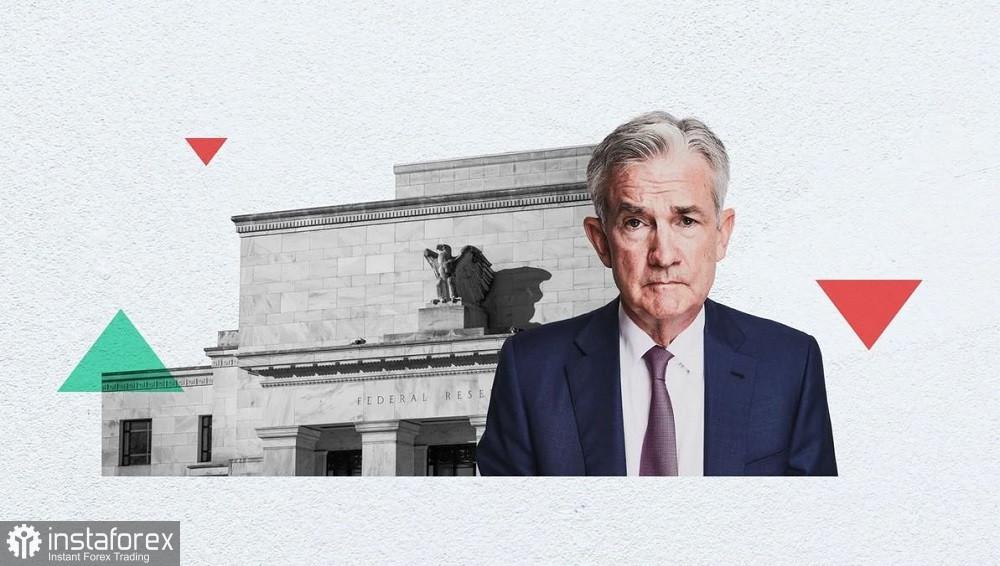The US Dollar Index significantly declined at the end of Wednesday, hitting a 2-week low. Federal Reserve Chair Jerome Powell's remarks in Congress did not sit well with the dollar bulls. Although, in general, his stance wasn't excessively dovish – the forecasts for monetary easing were vague, filled with numerous "buts" and "ifs." Therefore, the market reacted in this way towards the greenback due to its inflated expectations stemming from Powell's previous speeches. However, Powell decided to maintain a balanced tone in his rhetoric, and this worked against the U.S. currency.
On one hand, Powell said that the interest rates are likely at its peak. This implies that the next move will be a rate cut (the only question is when). On the other hand, Powell noted that progress on inflation "is not assured," so the rate cuts will have to be postponed until the central bank has "become more confident that inflation is moving sustainably to 2%,".
Powell did not provide any specific timelines for these actions.

In general, Powell's testimony in Congress did not provide any new insights for the markets. In fact, his colleague, Minneapolis Fed head Neel Kashkari was more informative. Kashkari said that he had penciled in two interest rate cuts in 2024.
However, such remarks did not strengthen the U.S. currency. The US Dollar Index fell towards the 103 level, and the EUR/USD pair tested the 1.09 level. In my opinion, we can explain this using several factors. Firstly, Powell's speech turned out to be vague, lacking any specific details. What are the conditions for monetary easing? What are the timelines? These questions remained unanswered, and this exerted pressure on the greenback. Secondly, all inflation indicators published in February demonstrated a downward trend, including the Fed's closely watched inflation measure – the core PCE price index. Therefore, Powell's words about a wait-and-see position in this context does not signal a significant delay. The market still expects a Fed rate cut in June or July.
As for Kashkari, it's worth noting that this year he does not have voting rights in the Committee. Moreover, he has previously advocated maintaining a wait-and-see stance: he expressed concern about the latest Nonfarm Payrolls data, and according to him, if the labor market remains strong, the Fed will have to gradually lower rates.
So, these are the reasons why dollar bulls were unhappy with yesterday's remarks – inflated expectations versus disappointing reality.
Powell's key message lies in a single phrase: "the central bank will begin cutting its key interest rate at some point this year, but not in the very near future." Meanwhile, according to the CME FedWatch Tool, the market is 100% confident that the Fed will not cut rates in March and almost certain (83%) that it will not do so at the next meeting in May. These forecasts align with Powell's statement that the central bank will not ease policy "in the very near future."
At the same time, June is not in the "very near future," so there's a high probability of a Fed rate cut here, practically 50/50.
In other words, Powell merely confirmed traders' confidence that the central bank will not touch the rate in the next two meetings. However, markets have already priced in this fact a long time ago. Therefore, the acknowledgment of the already-known fact disappointed the dollar bulls.
Moreover, interest in risk increased against the backdrop of recent news from Congress. The House of Representatives, controlled by Republicans, passed a bill to fund the federal government, thereby pushing back the threat of a partial shutdown. This is one of the six bills related to $460 billion in spending. The deadlines for the rest come a little later, on March 22.
Investors were also pleased with news from China. The country's foreign trade in goods stood at $931 billion. Exports surged 7.1% in January and February on an annual basis, whereas experts had anticipated a growth rate of only 1.9%. China's imports increased by 3.5% from a year earlier (compared to a forecasted growth of only 0.2%).
As a result, the dollar came under pressure due to Powell's statements and amid growing interest in riskier assets.
However, at the end of the day, the EUR/USD pair remained within the 1.08 level. To confirm the bullish scenario, buyers need to settle above the resistance level of 1.0900 (the lower boundary of the Kumo cloud, coinciding with the upper line of the Bollinger Bands indicator on the daily chart). The previous day's attempt failed, and this should alert supporters of long positions. Therefore, until the pair consolidates above 1.0900, it is advisable to take a wait-and-see position.



Hot
No comment on record. Start new comment.